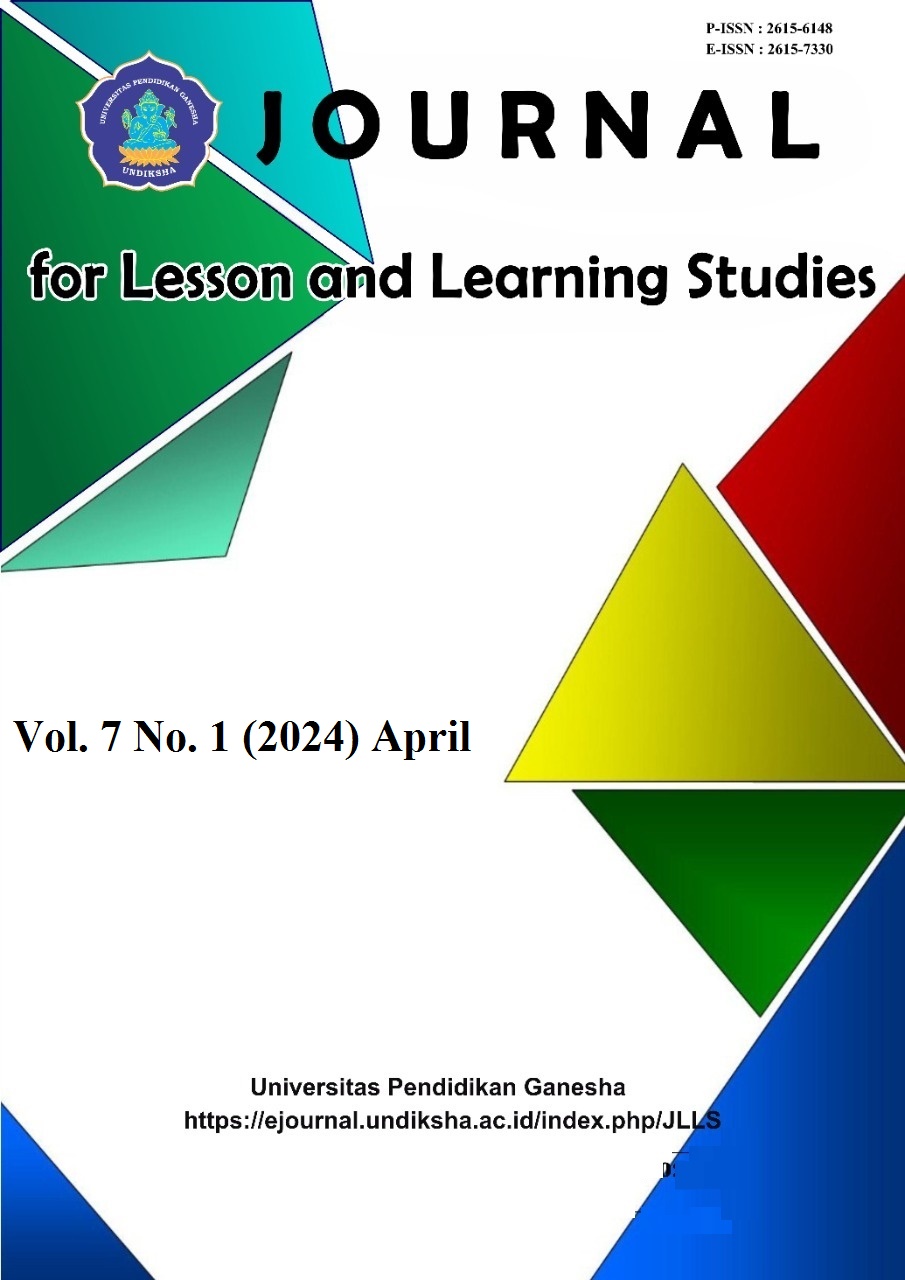The Impact of Learning Skills on Academic Achievement and Learning Outcomes in High School
DOI:
https://doi.org/10.23887/jlls.v7i1.68104Keywords:
Learning skills, student academic achievement, skills, AchievementAbstract
In obtaining student achievements and learning outcomes, students must have good skills and abilities. However, the fact is that many students still have low achievement and learning outcomes. This is urgent to research because there is a difference between theoretical expectations and reality to analyze learning skills and academic achievement within groups and to analyze differences in learning skills between male students and female students. The method in this research is quantitative by testing ANOVA. The subjects were 180 high school students. Data collection technique is using a learning skills instrument that contains two parts. The first section contains the demographics of the respondents. The second part also contains questions regarding learning skills. Instruments are assessed on a critical scale of 1 to 5 by distributing instruments using Google. A data analysis technique is using SPSS Version 25.0. Data analysis was analyzed using the Pearson correlation test to measure the relationship between learning skills and academic achievement. The results and findings show that the exam results show that there are no significant differences in learning skills among fourth-level students of different genders. ANOVA test results show that there are differences in learning skills among students in achieving academic achievement. The Pearson correlation test shows that there is a positive relationship between learning proficiency and academic achievement. The conclusion is that in obtaining achievements and learning outcomes, individual student learning skills and good academic performance are still needed.
References
Akpur, U. (2020). Critical, Reflective, Creative Thinking and Their Reflections on Academic Achievement. Thinking Skills and Creativity, 37(July), 1-8. https://doi.org/10.1016/j.tsc.2020.100683. DOI: https://doi.org/10.1016/j.tsc.2020.100683
Alam, G. M., Al-Amin, A. Q., Forhad, A. R., & Mubarak, M. S. (2020). Does the private university sector exploit sustainable residential life in the name of supporting the fourth industrial revolution? Technological Forecasting and Social Change, 159(July), 120200.1-13. https://doi.org/10.1016/j.techfore.2020.120200. DOI: https://doi.org/10.1016/j.techfore.2020.120200
Alghamdi, A., Karpinski, A. C., Lepp, A., & Barkley, J. (2020). Online and face-to-face classroom multitasking and academic performance: Moderated mediation with self-efficacy for self-regulated learning and gender. Computers in Human Behavior, 102(February 2019), 214–222. https://doi.org/10.1016/j.chb.2019.08.018. DOI: https://doi.org/10.1016/j.chb.2019.08.018
Avant, N. D., & Gillespie, G. L. (2019). Pushing for health equity through structural competency and implicit bias education: A qualitative evaluation of a racial/ethnic health disparities elective course for pharmacy learners. Currents in Pharmacy Teaching and Learning, 11(4), 382–393. https://doi.org/10.1016/j.cptl.2019.01.013. DOI: https://doi.org/10.1016/j.cptl.2019.01.013
Bahtiyar, S., Gulmez Karaca, K., Henckens, M. J. A. G., & Roozendaal, B. (2020). Norepinephrine and glucocorticoid effects on the brain mechanisms underlying memory accuracy and generalization. Molecular and Cellular Neuroscience, 108(July), 103537.1-10. https://doi.org/10.1016/j.mcn.2020.103537. DOI: https://doi.org/10.1016/j.mcn.2020.103537
Behnamnia, N., Kamsin, A., Ismail, M. A. B., & Hayati, A. (2020). The effective components of creativity in digital game-based learning among young children: A case study. Children and Youth Services Review, 116(March 2020), 105227.1-13. https://doi.org/10.1016/j.childyouth.2020.105227. DOI: https://doi.org/10.1016/j.childyouth.2020.105227
Butler-Henderson, K., & Crawford, J. (2020). A systematic review of online examinations: A pedagogical innovation for scalable authentication and integrity. Computers and Education, 159(May), 104024.1-12. https://doi.org/10.1016/j.compedu.2020.104024. DOI: https://doi.org/10.1016/j.compedu.2020.104024
Byrnes, J. P. (2020). The potential utility of an opportunity-propensity framework for understanding individual and group differences in developmental outcomes: A retrospective progress report. Developmental Review, 56(March), 100911.1-20. https://doi.org/10.1016/j.dr.2020.100911. DOI: https://doi.org/10.1016/j.dr.2020.100911
Cardin, V., Grin, K., Vinogradova, V., & Manini, B. (2020). Crossmodal reorganisation in deafness: Mechanisms for functional preservation and functional change. Neuroscience and Biobehavioral Reviews, 113(March), 227–237. https://doi.org/10.1016/j.neubiorev.2020.03.019. DOI: https://doi.org/10.1016/j.neubiorev.2020.03.019
Chen, J., Kolmos, A., & Du, X. (2021). Forms of implementation and challenges of PBL in engineering education: a review of literature. European Journal of Engineering Education, 46(1), 90–115. https://doi.org/10.1080/03043797.2020.1718615. DOI: https://doi.org/10.1080/03043797.2020.1718615
Conway, C. M. (2020). How does the brain learn environmental structure? Ten core principles for understanding the neurocognitive mechanisms of statistical learning. Neuroscience and Biobehavioral Reviews, 112(February), 279–299. https://doi.org/10.1016/j.neubiorev.2020.01.032. DOI: https://doi.org/10.1016/j.neubiorev.2020.01.032
Davis, F. M., Dendekker, A., Joshi, A., Wolf, S., Moore, B., Lukacs, N., & Gallagher, K. (2020). Epigenetic Regulation of Toll-like Receptor 4 Signaling Modulates Macrophage Phenotype and Impairs Diabetic Wound Healing. Journal of Vascular Surgery, 72(1), e260. https://doi.org/10.1016/j.jvs.2020.04.431. DOI: https://doi.org/10.1016/j.jvs.2020.04.431
Didin Sonmez, F., Cuhadar, S., & Kahvecioglu, M. K. (2021). Successes, challenges, and next steps in implementing outcome-based assessment: The case of Istanbul Bilgi University Library. Journal of Academic Librarianship, 47(1), 102249.1-8. https://doi.org/10.1016/j.acalib.2020.102249. DOI: https://doi.org/10.1016/j.acalib.2020.102249
Dimova, S. (2020). English language requirements for enrolment in EMI programs in higher education: A European case. Journal of English for Academic Purposes, 47(September 2020), 100896.1-40. https://doi.org/10.1016/j.jeap.2020.100896. DOI: https://doi.org/10.1016/j.jeap.2020.100896
Elfeky, A. I. M., Masadeh, T. S. Y., & Elbyaly, M. Y. H. (2020). Advance organizers in flipped classroom via e-learning management system and the promotion of integrated science process skills. Thinking Skills and Creativity, 35(March 2020), 100622.1-32. https://doi.org/10.1016/j.tsc.2019.100622. DOI: https://doi.org/10.1016/j.tsc.2019.100622
Feng, Y., Marchal, T., Sperry, T., & Yi, H. (2020). Influence of wind and relative humidity on the social distancing effectiveness to prevent COVID-19 airborne transmission: A numerical study. Journal of Aerosol Science, 147(April), 105585.1-19. https://doi.org/10.1016/j.jaerosci.2020.105585. DOI: https://doi.org/10.1016/j.jaerosci.2020.105585
Huang, S. Y., Kuo, Y. H., & Chen, H. C. (2020). Applying digital escape rooms infused with science teaching in elementary school: Learning performance, learning motivation, and problem-solving ability. Thinking Skills and Creativity, 37(129), 100681. https://doi.org/10.1016/j.tsc.2020.100681. DOI: https://doi.org/10.1016/j.tsc.2020.100681
Iglesias-Pradas, S., Hernández-García, Á., Chaparro-Peláez, J., & Prieto, J. L. (2021). Emergency remote teaching and students’ academic performance in higher education during the COVID-19 pandemic: A case study. Computers in Human Behavior, 119. https://doi.org/10.1016/j.chb.2021.106713. DOI: https://doi.org/10.1016/j.chb.2021.106713
Khaldi, K. (2017). Quantitative, qualitative or mixed research: which research paradigm to use? Journal of Educational and Social Research, 7(2), 15–15. https://doi.org/10.5901/jesr.2017.v7n2p15. DOI: https://doi.org/10.5901/jesr.2017.v7n2p15
Kipper, L. M., Furstenau, L. B., Hoppe, D., Frozza, R., & Iepsen, S. (2020). Scopus scientific mapping production in industry 4.0 (2011–2018): a bibliometric analysis. International Journal of Production Research, 58(6), 1605–1627. https://doi.org/10.1080/00207543.2019.1671625. DOI: https://doi.org/10.1080/00207543.2019.1671625
Kozhevnikov, M., Evans, C., & Kosslyn, S. M. (2014). Cognitive style as environmentally sensitive individual differences in cognition: A modern synthesis and applications in education, business, and management. Psychological Science in the Public Interest, Supplement, 15(1), 3–33. https://doi.org/10.1177/1529100614525555. DOI: https://doi.org/10.1177/1529100614525555
Kucuk, S., & Sisman, B. (2020). Students’ attitudes towards robotics and STEM: Differences based on gender and robotics experience. International Journal of Child-Computer Interaction, 23–24(June 2020), 100167.1-8. https://doi.org/10.1016/j.ijcci.2020.100167. DOI: https://doi.org/10.1016/j.ijcci.2020.100167
Langum, V., & Sullivan, K. P. H. (2020). Academic writing, scholarly identity, voice and the benefits and challenges of multilingualism: Reflections from Norwegian doctoral researchers in teacher education. Linguistics and Education, 60(December 2020,), 100883.1-10. https://doi.org/10.1016/j.linged.2020.100883. DOI: https://doi.org/10.1016/j.linged.2020.100883
Lee, Y. C., Shariatfar, M., Rashidi, A., & Lee, H. W. (2020). Evidence-driven sound detection for prenotification and identification of construction safety hazards and accidents. Automation in Construction, 113(January 2019), 103127.1-16. https://doi.org/10.1016/j.autcon.2020.103127. DOI: https://doi.org/10.1016/j.autcon.2020.103127
Lin, G. Y. (2020). Scripts and mastery goal orientation in face-to-face versus computer-mediated collaborative learning: Influence on performance, affective and motivational outcomes, and social ability. Computers and Education, 143(January 2020), 103691.1-36. https://doi.org/10.1016/j.compedu.2019.103691. DOI: https://doi.org/10.1016/j.compedu.2019.103691
Listyaningsih, T. (2017). The Influence of Listening English Song to Improve Listening Skill in Listening Class. Journal of Multidisciplinary Studies, 1(1), 35–49. https://ejournal.uinsaid.ac.id/index.php/academica/article/view/601. DOI: https://doi.org/10.22515/academica.v1i1.601
Mahfud, T., Triyono, M. B., Sudira, P., & Mulyani, Y. (2020). The influence of social capital and entrepreneurial attitude orientation on entrepreneurial intentions: the mediating role of psychological capital. European Research on Management and Business Economics, 26(1), 33–39. https://doi.org/10.1016/j.iedeen.2019.12.005. DOI: https://doi.org/10.1016/j.iedeen.2019.12.005
Mas-Tur, A., Kraus, S., Brandtner, M., Ewert, R., & Kürsten, W. (2020). Advances in management research: a bibliometric overview of the Review of Managerial Science. Review of Managerial Science, 14(5), 933–958. https://doi.org/10.1007/s11846-020-00406-z. DOI: https://doi.org/10.1007/s11846-020-00406-z
Onen D. (2016). Conceptualisation : The Foundation of Any Solid Quantitative. The Electronic Journal of Business Research Methods, 14(1), 28–38. https://academic-publishing.org/index.php/ejbrm.
Papavlasopoulou, S., Sharma, K., & Giannakos, M. N. (2020). Coding activities for children: Coupling eye-tracking with qualitative data to investigate gender differences. Computers in Human Behavior, 105(7491), 1–11. https://doi.org/10.1016/j.chb.2019.03.003. DOI: https://doi.org/10.1016/j.chb.2019.03.003
Powers, K., & Mandal, A. (2011). Tier III Assessments, Data-Based Decision Making, and Interventions. Contemporary School Psychology, 15(1), 21–33. https://doi.org/10.1007/bf03340960. DOI: https://doi.org/10.1007/BF03340960
Rodríguez-Hernández, C. F., Cascallar, E., & Kyndt, E. (2020). Socio-economic status and academic performance in higher education: A systematic review. Educational Research Review, 29(February 2020), 100305.1-75. https://doi.org/10.1016/j.edurev.2019.100305. DOI: https://doi.org/10.1016/j.edurev.2019.100305
Scheibenzuber, C., Hofer, S., & Nistor, N. (2021). Designing for fake news literacy training: A problem-based undergraduate online-course. Computers in Human Behavior, 121(March), 106796.1-13. https://doi.org/10.1016/j.chb.2021.106796. DOI: https://doi.org/10.1016/j.chb.2021.106796
Sember, V., Jurak, G., Kovač, M., Morrison, S. A., & Starc, G. (2020). Children’s Physical Activity, Academic Performance, and Cognitive Functioning: A Systematic Review and Meta-Analysis. Frontiers in Public Health, 8(July), 1-17. https://doi.org/10.3389/fpubh.2020.00307. DOI: https://doi.org/10.3389/fpubh.2020.00307
Smith, B., & Monforte, J. (2020). Stories, new materialism and pluralism: Understanding, practising and pushing the boundaries of narrative analysis. Methods in Psychology, 2(March), 100016.1-8. https://doi.org/10.1016/j.metip.2020.100016. DOI: https://doi.org/10.1016/j.metip.2020.100016
Subasi, A., Khateeb, K., Brahimi, T., & Sarirete, A. (2019). Human activity recognition using machine learning methods in a smart healthcare environment. In Innovation in Health Informatics: A Smart Healthcare Primer. Elsevier Inc. https://doi.org/10.1016/B978-0-12-819043-2.00005-8. DOI: https://doi.org/10.1016/B978-0-12-819043-2.00005-8
Suparman, Y., & Arifin, N. (2021). Enhancing mathematical problem-solving skills of indonesian junior high school students through problem-based learning: A systematic review and meta-analysis. Al-Jabar: Jurnal Pendidikan, 12(1), 1–16. https://doi.org/10.24042/ajpm.v12i1.8036. DOI: https://doi.org/10.24042/ajpm.v12i1.8036
Thomas, J., & Mengel, T. (2008). Preparing project managers to deal with complexity - Advanced project management education. International Journal of Project Management, 26(3), 304–315. https://doi.org/10.1016/j.ijproman.2008.01.001. DOI: https://doi.org/10.1016/j.ijproman.2008.01.001
Valtonen, T., Hoang, N., Sointu, E., Näykki, P., Virtanen, A., Pöysä-Tarhonen, J., & Kukkonen, J. (2021). How pre-service teachers perceive their 21st-century skills and dispositions: A longitudinal perspective. Computers in Human Behavior, 116, 106643. https://doi.org/10.1016/j.chb.2020.106643. DOI: https://doi.org/10.1016/j.chb.2020.106643
Van Oers, B. (2018). Long-Standing and Innovative Programs in Early Childhood Education: An Introduction. In International Handbook of Early Childhood Education (pp. 969–993). https://doi.org/10.1007/978-94-024-0927-7_50. DOI: https://doi.org/10.1007/978-94-024-0927-7_50
Vidergor, H. E., & Ben-Amram, P. (2020). Khan academy effectiveness: The case of math secondary students’ perceptions. Computers and Education, 157(July), 103985.1-12. https://doi.org/10.1016/j.compedu.2020.103985. DOI: https://doi.org/10.1016/j.compedu.2020.103985
Villacís, J. L., Naval, C., & De la Fuente, J. (2022). Character strengths, moral motivation and vocational identity in adolescents and young adults: a scoping review. Current Psychology, 2(July 2022), 1–16. https://doi.org/10.1007/s12144-022-03427-x. DOI: https://doi.org/10.1007/s12144-022-03427-x
Wang, X., Margulies, D. S., Smallwood, J., & Jefferies, E. (2020). A gradient from long-term memory to novel cognition: Transitions through default mode and executive cortex. NeuroImage, 220(March), 117074.1-12. https://doi.org/10.1016/j.neuroimage.2020.117074. DOI: https://doi.org/10.1016/j.neuroimage.2020.117074
Zaid, N. N. M., Rauf, M. F. A., Ahmad, N. A., Zainal, A., Razak, F. H. A., & Shahdan, T. S. T. (2022). Learning elements for digital literacy among elderly: A scoping review. Journal of Algebraic Statistics, 13(3), 2850–2859. https://doi.org/ISSN: 1309-3452.
Zhang, H., Gupta, S., Sun, W., & Zou, Y. (2020). How social-media-enabled co-creation between customers and the firm drives business value? The perspective of organizational learning and social Capital. Information and Management, 57(3), 103200.1-17. https://doi.org/10.1016/j.im.2019.103200. DOI: https://doi.org/10.1016/j.im.2019.103200
Downloads
Published
How to Cite
Issue
Section
License
Copyright (c) 2024 Asri, Asniwati, Irwan

This work is licensed under a Creative Commons Attribution-ShareAlike 4.0 International License.
Authors who publish with the Journal for Lesson and Learning Studies agree to the following terms:
- Authors retain copyright and grant the journal the right of first publication with the work simultaneously licensed under a Creative Commons Attribution License (CC BY-SA 4.0) that allows others to share the work with an acknowledgment of the work's authorship and initial publication in this journal.
- Authors are able to enter into separate, additional contractual arrangements for the non-exclusive distribution of the journal's published version of the work (e.g., post it to an institutional repository or publish it in a book), with an acknowledgment of its initial publication in this journal.
- Authors are permitted and encouraged to post their work online (e.g., in institutional repositories or on their website) prior to and during the submission process, as it can lead to productive exchanges, as well as earlier and greater citation of published work. (See The Effect of Open Access)




